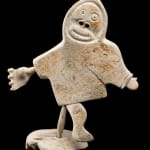-
Artworks
KAROO ASHEVAK (1940-1974) TALOYOAK (SPENCE BAY)
Dancing Man, 1971whale bone, ivory, and stone, 11.75 x 10 x 5 in (29.8 x 25.4 x 12.7 cm)
signed "ᑲᔪ".LOT 64
ESTIMATE: $20,000 — $30,000Further images
Karoo Ashevak’s fabulous and bizarre 'surreal' constructions in whalebone, meticulously carved and augmented with contrasting details in other materials, explored his private world of dreams and the spirit world of...Karoo Ashevak’s fabulous and bizarre "surreal" constructions in whalebone, meticulously carved and augmented with contrasting details in other materials, explored his private world of dreams and the spirit world of the Netsilik and seemed to transcend popular notions about what constituted Inuit art. They somehow struck a universal chord and spoke to a surprisingly wide range of art collectors and critics; they continue to do so today. Karoo's ability to communicate psychological, emotional and/or spiritual meaning directly to the viewer, together with his brilliant imagination and extraordinary skill as a sculptor, are as fresh and compelling as they were over fifty years ago.
Like his marvelous Head (Lot 32 in this auction), also carved in 1971, Dancing Man has one large eye and one small one – an important stylistic innovation by the artist. Apparently, Karoo was acquainted with an old shaman who had one large eye and one small eye (or no eye, depending on the report). Inspiration aside, facial asymmetry became a trademark of Karoo’s style. Dancing Man certainly might portray a shaman, but we think it’s fun to wonder if it might not be a self-portrait, given Karoo’s reputation as a fun-loving and excitable person. Jean Blodgett’s landmark solo exhibition catalogue includes a similarly posed Dancing Man, c. 1971. [1] Our example also features other important innovations which first appear in 1971: the detachable (and also mismatched) hand; and a single leg (with the peg possibly standing in for the second one).
But quite apart from the historical importance of these novel attributes, the figure itself is incredibly charming. It really feels as if this fellow is performing just for us. The sculpture is beautifully composed and balanced as well, with the parka tip, hands and leg pointing in the four cardinal directions. The main piece of flat bone is remarkably expressive as well: porous yet relatively smooth in front and dramatically scarred at the back. Fantastic.
1. Jean Blodgett, Karoo Ashevak, (Winnipeg Art Gallery, 1977), cat. 16.
References: The most important sources of information about the artist and his works are Jean Blodgett retrospective exhibition catalogue Karoo Ashevak, (Winnipeg Art Gallery, 1977), and American Indian Arts Center, Karoo Ashevak: Spirits, (New York: American Indian Arts Center, 1972). For works by Karoo with similar details and subject matter see Gerald McMaster, ed., Inuit Modern: The Samuel and Esther Sarick Collection, (Toronto: Art Gallery of Ontario, 2010), p. 118; and Maria von Finckenstein ed., Celebrating Inuit Art 1948-1970, (Hull, QC: Canadian Museum of Civilization, 1999), p. 187.Provenance
Purchased from an art gallery in Yellowknife in 1971;
by descent to the present Private Collection, Ottawa.
Join our mailing list
* denotes required fields
We will process the personal data you have supplied in accordance with our privacy policy (available on request). You can unsubscribe or change your preferences at any time by clicking the link in our emails.










